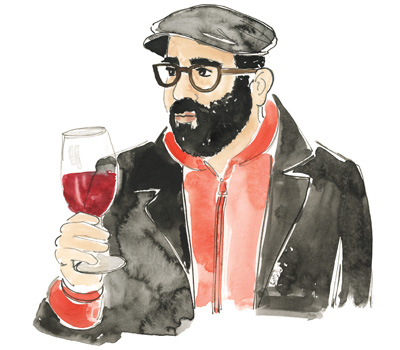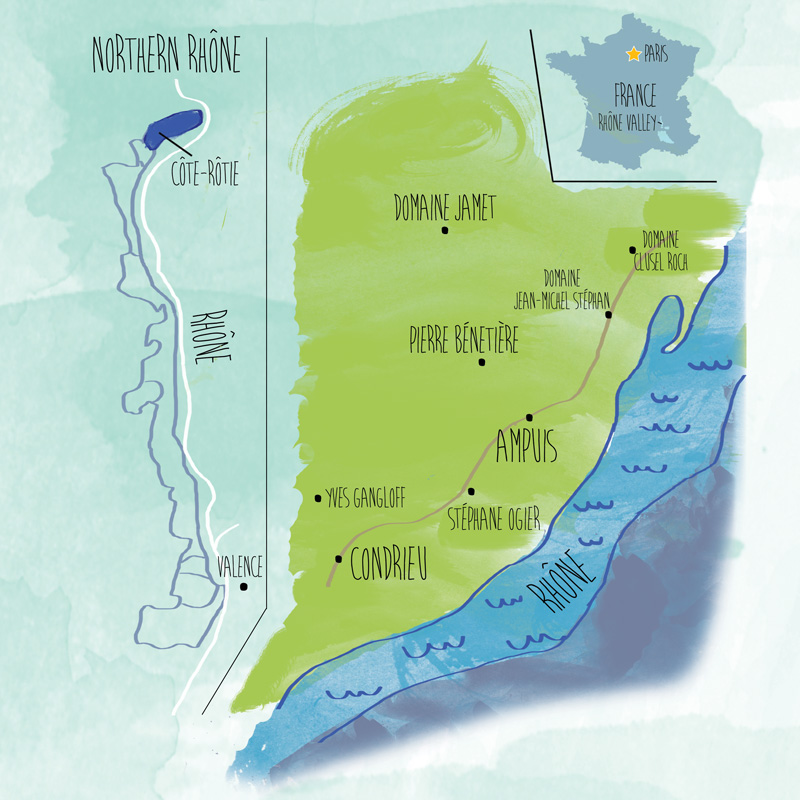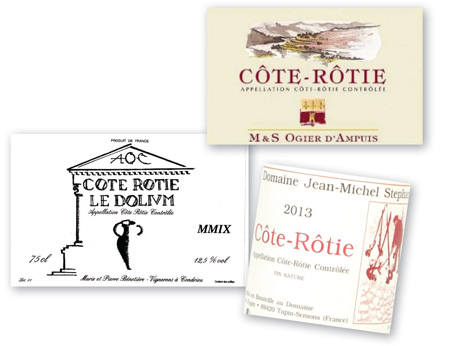The year was 1998, and Rajat Parr was dining at La Pyramide in Vienne, the gateway to the Northern Rhône and Côte Rôtie. To prime himself for his inaugural visit to the region, he ordered a bottle of a wine he knew should be good: the 1990 Clusel-Roch Les Grandes Places—great producer, great vintage. Having been a sommelier for only two years, Parr was familiar with Côte Rôtie wines, but had yet to fall under their spell. That was about to change.


At the time, Parr worked at San Francisco’s Rubicon, the first stop on what would be a storied career as a sommelier for Fifth Floor and then the Michael Mina group, before he gradually transitioned into his current life as a vintner in Santa Barbara (Domaine de la Côte, Sandhi) and Oregon (Evening Land).
Parr’s devotion to Côte Rôtie is about more than the wine. “From my first visit to now, it’s one of the regions that hasn’t changed that much,” he says. “Burgundy has become very refined, but Ampuis is still very much a town of hard-working farmers.” The landscape, too, is part of the appeal. “Visually, Côte Rôtie is one of the most spectacular hillsides in the world,” he says. “It springs right up from the bank of the Rhône River with this massively steep hillside.”
As for the wines, he thrills to the fact that the wines can be a collection of seeming contradictions that are somehow resolved in the mouth. “The tannins may be silky, yet the flavors are wild, with
crazy flavor juxtapositions of flowers and blood, mushrooms and spice, fruit and meat.”
The diversity of expressions within this small area is also intriguing: “The difference between schist and granite is the most famous distinction in Côte Rôtie,” he says. “The Côte Brune to the north features darker, schist-based soils, while the Côte Blonde to the south has lighter soils of granite. But there are many more things that impact the wine—gradations in soil and slope; the genetic material of the vine and its age; whether or not the clusters are destemmed.” He chose the following wines to illustrate the most salient things he’s learned about Côte Rôtie since that lunch 18 years ago.


1. Domaine Jamet Côte Rôtie
“For me, this is the quintessential expression of Côte Rôtie,” says Parr. “It’s not always the best wine of the vintage, but it sets the tone.” The fruit comes from almost a dozen sites on the hill on a variety of soils, mostly fermented as whole clusters, aged in virtually no new wood. “The wine is savory and peppery with some wild, gamey notes,” he says, “but it’s also got a big, round, soft core of fruit.”
2. Domaine Ogier Côte Rôtie Cuvée Lancement
“Stéphane Ogier is a young, ambitious producer. Early on he made modern, rich, oakdriven wines but now he makes very clean, very precise wines, and he’s interested in understanding his terroirs. Lancement is his family’s jewel of a vineyard on the Côte Blonde, very steep, and it shows the way Côte Rôtie can blend power with incredible finesse from the granite soil. It’s a pinot lover’s Côte Rôtie.”
3. Domaine Jean-Michel Stephan Côte Rôtie
“Jean-Michel Stephan is the epitome of the small, garagiste-style of producer, making only a small amount of this wine in a cellar attached to his house from vineyards directly up a slope behind his house. More importantly, he’s completely organic, which is rare in Côte Rôtie, using whole bunches and only a smidgen of sulfur at bottling. His wines emphasize fruit. This wine contains around ten percent viognier, a high percentage in Côte Rôtie. That, and the fact that he starts his ferments with carbonic maceration, give the wine its remarkable, lustrous texture and floral tones.”


4. Pierre Bénetière Côte Rôtie Dolium
“Pierre Bénetière, like Jean-Michel Stephan, is a one-man show making incredibly small amounts of wine,” Parr says. “Dolium comes from a single hectare that is entirely contained within Guigal’s famous La Turque vineyard.” Parr describes the wine as “a dark, wild, brooding one from schist soils.”
5. Yves Gangloff Côte Rôtie La Sereine Noir
“This wine is interesting because it’s 100 percent sérine,” says Parr, referencing the local variation of syrah that was common before the arrival of more modern clones. “It looks different from syrah, needs to be pruned di erently, has smaller berries and makes wild, highly aromatic wines. Many people have some sérine, but few do a complete bottling, especially one as dark and captivating as Gangloff’s.”
6. Domaine Clusel-Roch Côte Rôtie Les Grandes Places
“From one of the greatest single vineyards in Côte Rôtie, this wine represents what a modern-ish style can do for a wine, when it’s not overdone. The winemaking is very classic, but there’s about 50 percent new oak, which gives the wine a sheen and a polish that’s not there in many wines. Grandes Places is the iron fist in the velvet glove, from the super-steep schist and mica of the Côte Brune.”
This story was featured in W&S Fall 2016.
illustration by Veronica Collington
Jordan Mackay’s writing on wine, spirits and food has appeared in the New York Times, Los Angeles Times, San Francisco Chronicle, Decanter, the Art of Eating and many other publications. While Secrets of the Sommeliers, the book he wrote with Rajat Parr, won a James Beard Award in 2011, it’s certain winemakers that he credits with some of his most important tasting lessons.
This story appears in the print issue of fal 2016.
Like what you read? Subscribe today.
















